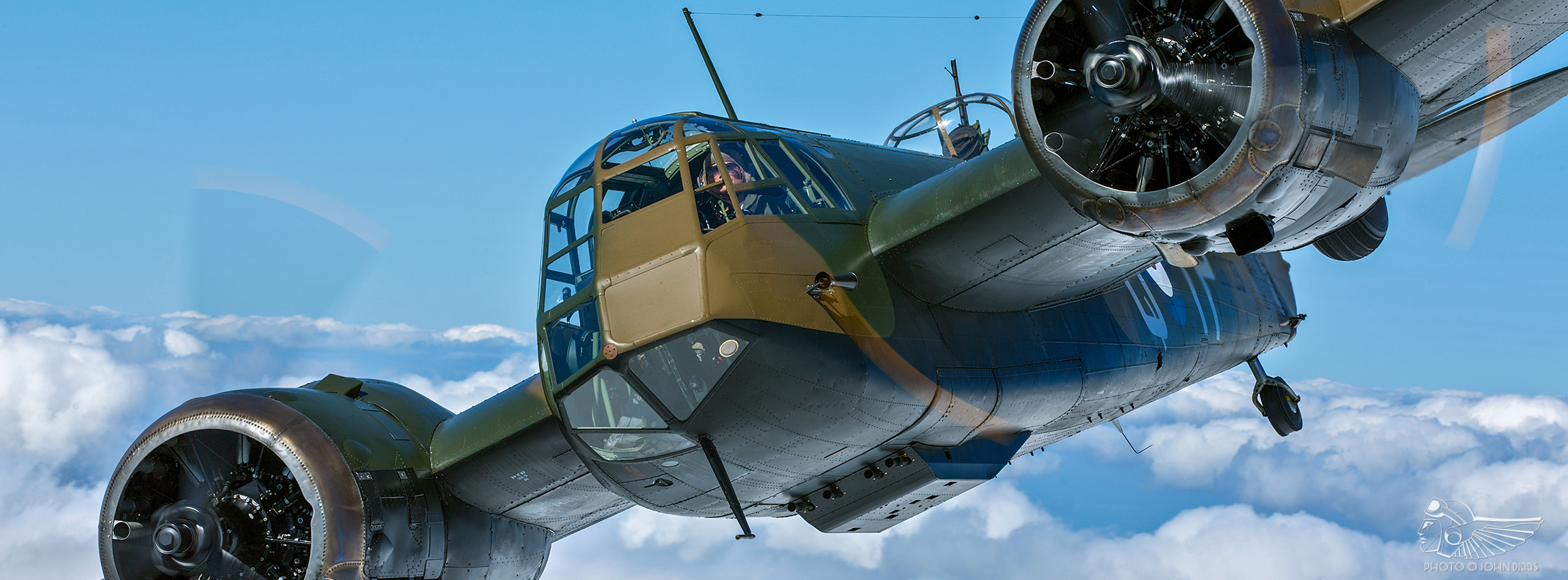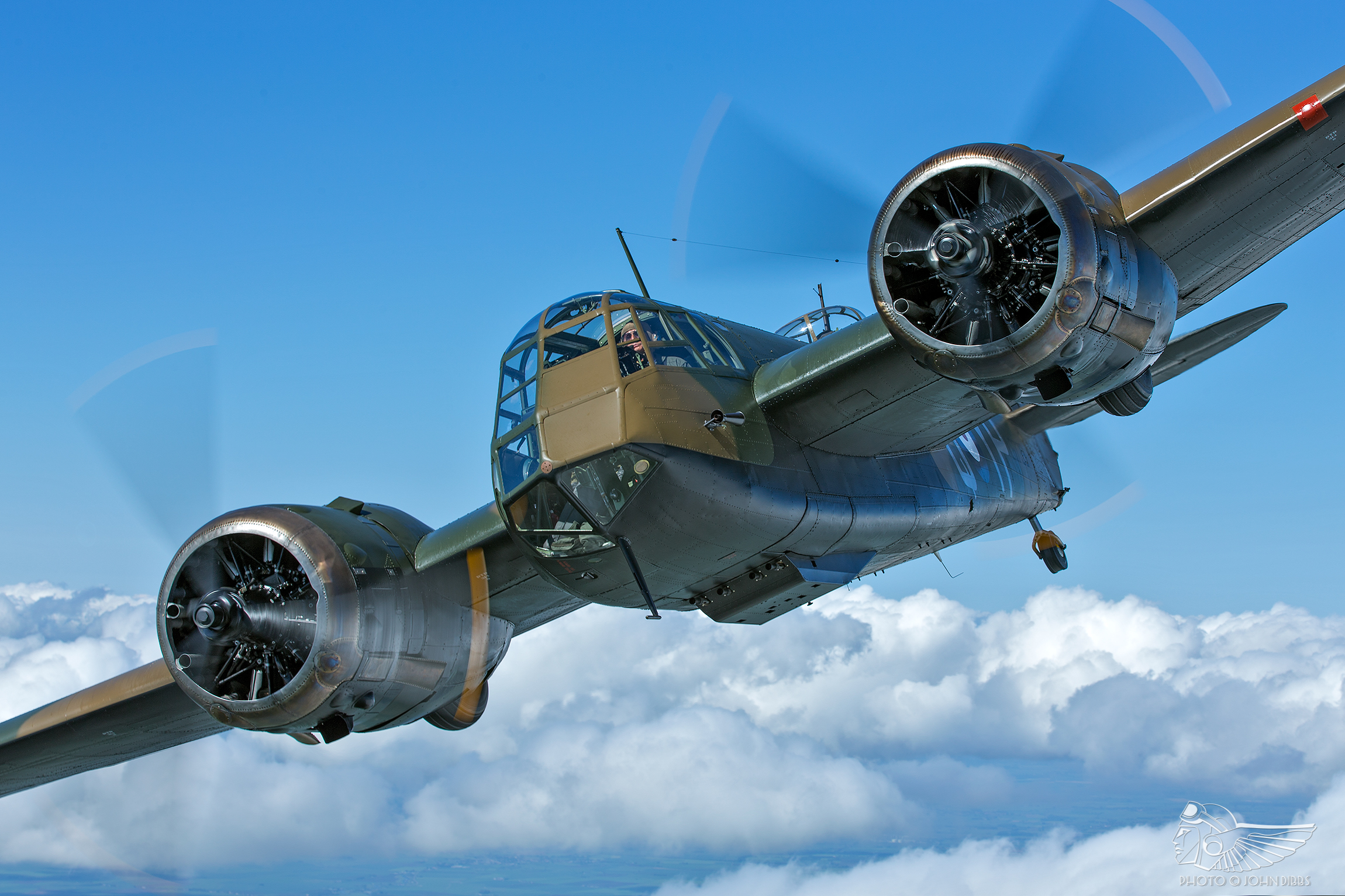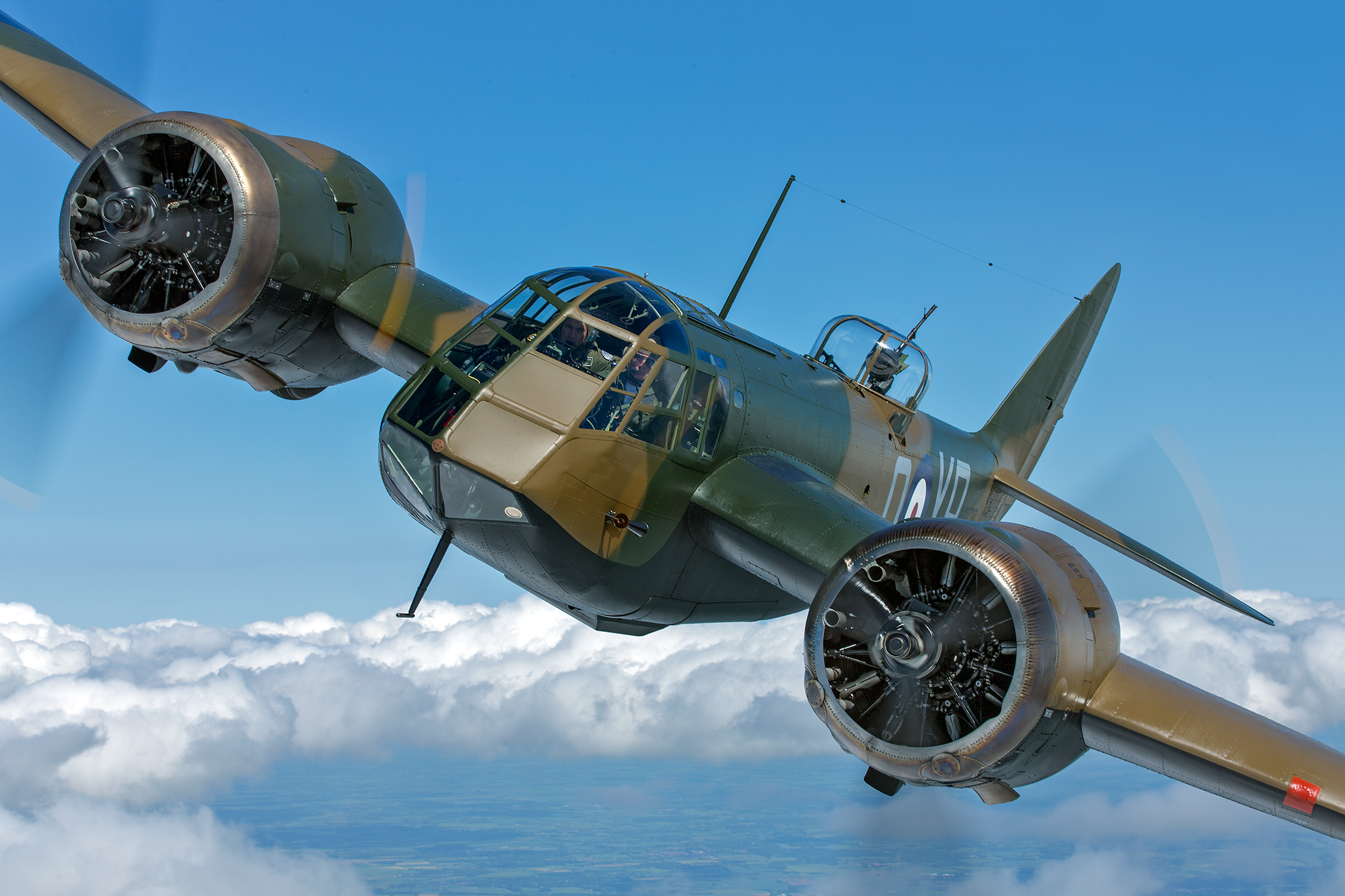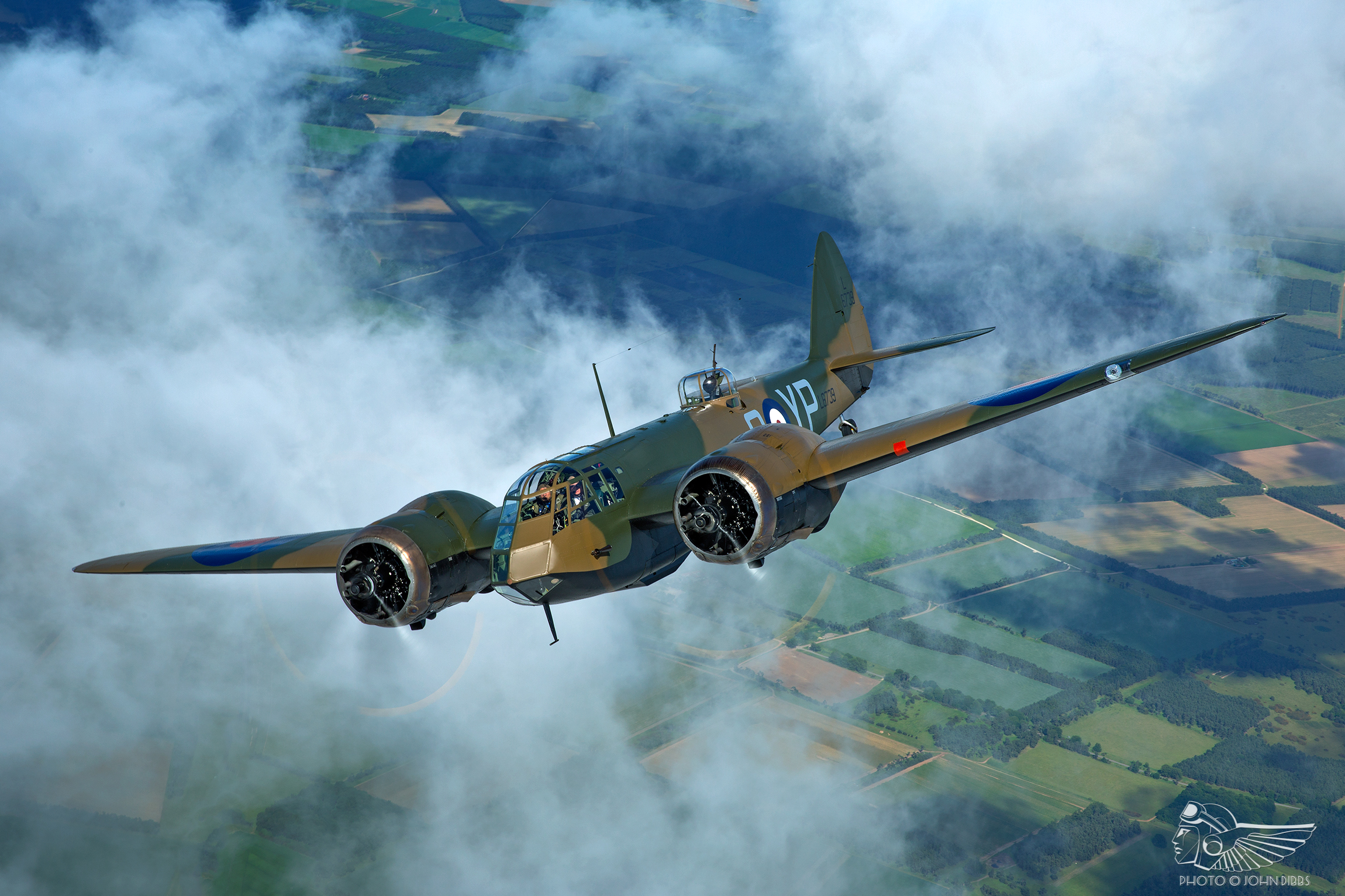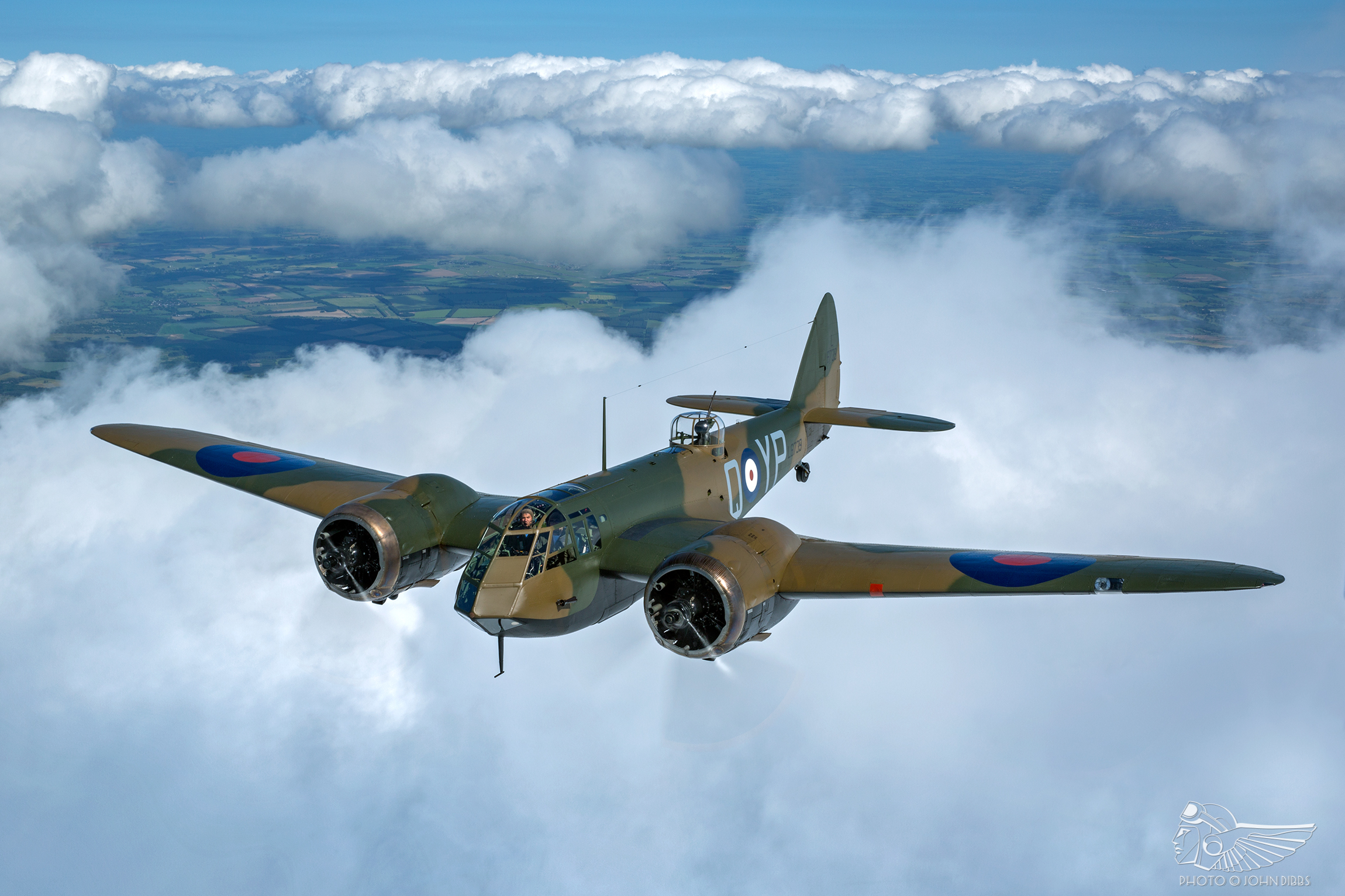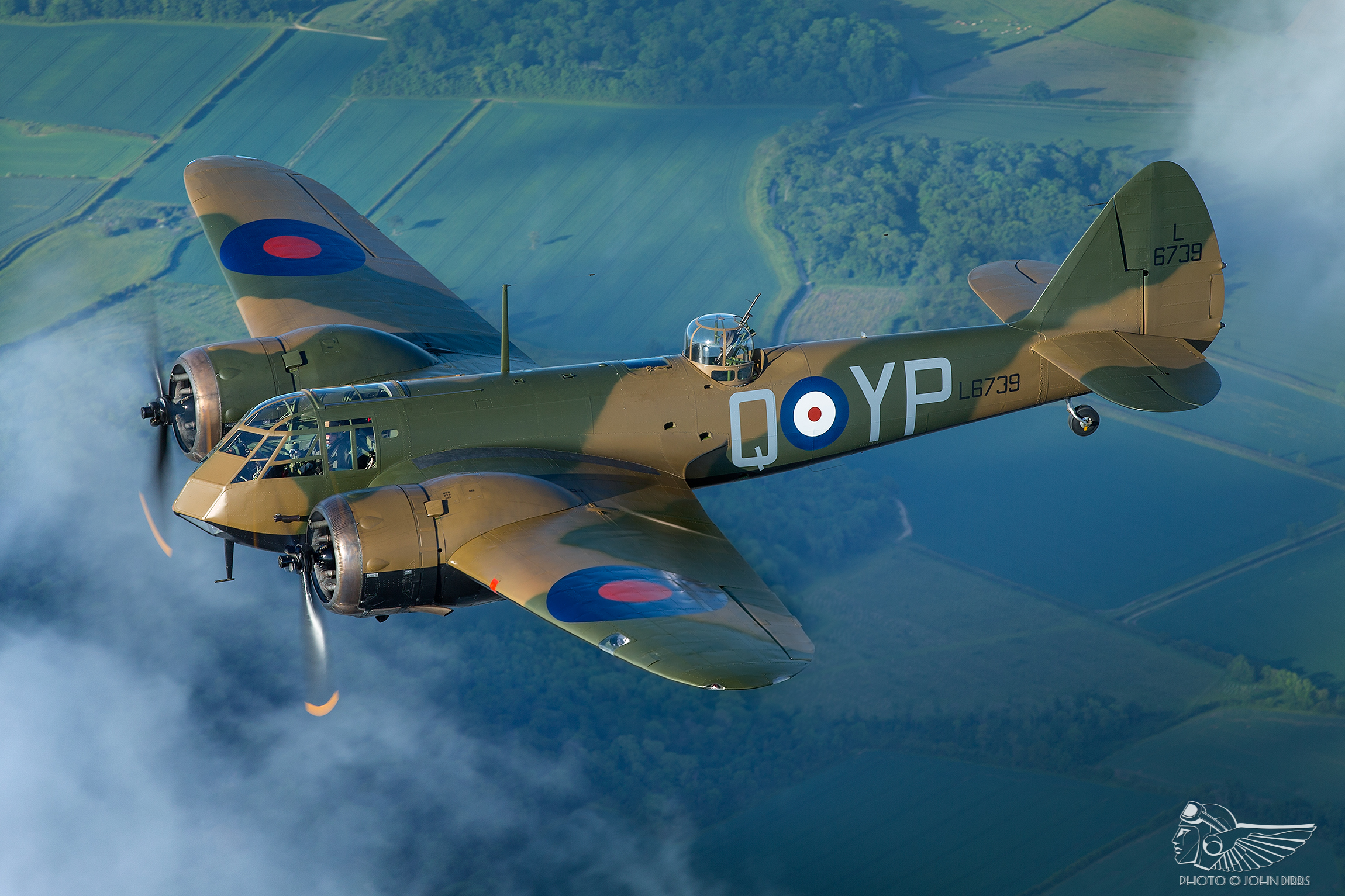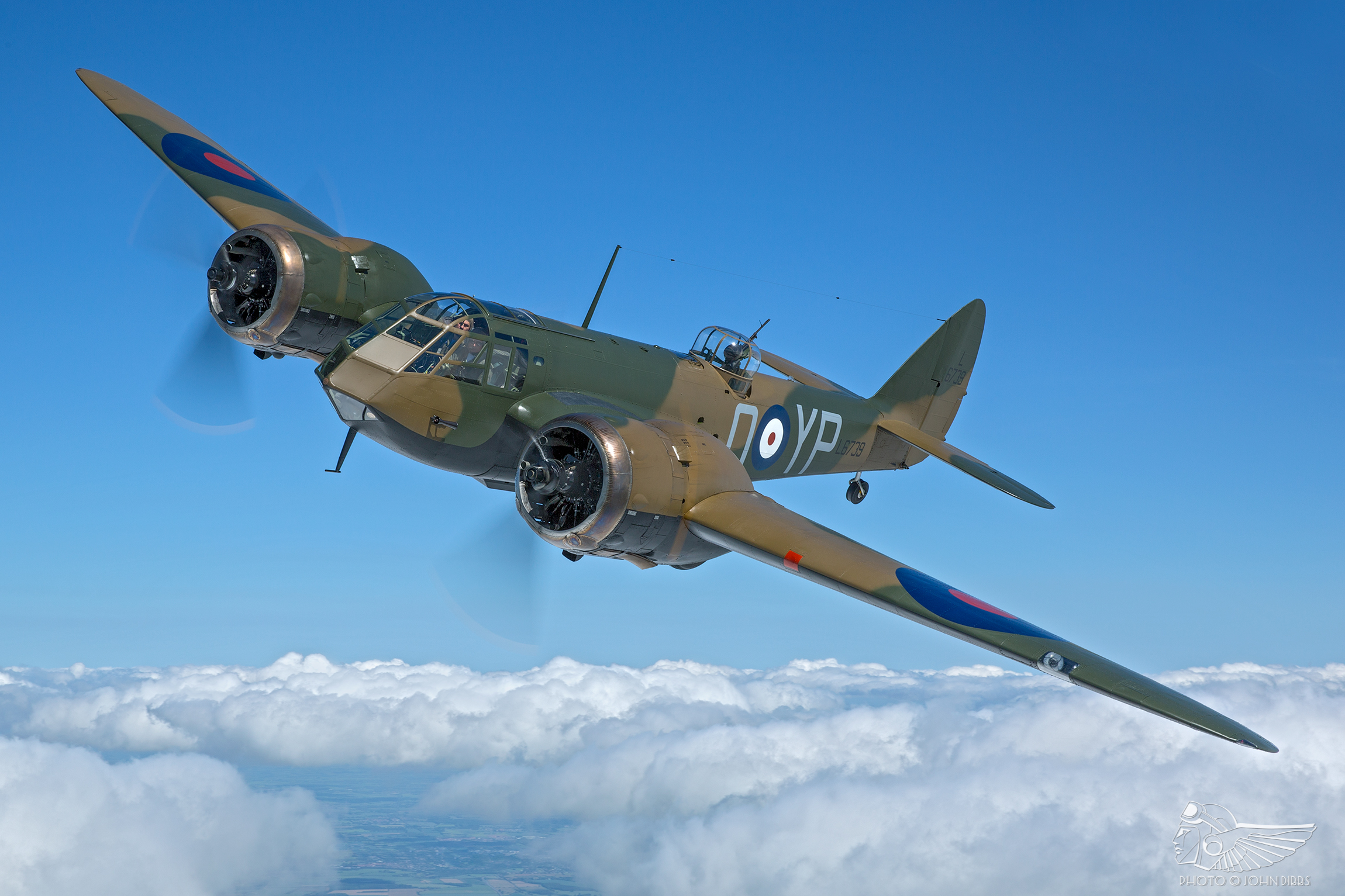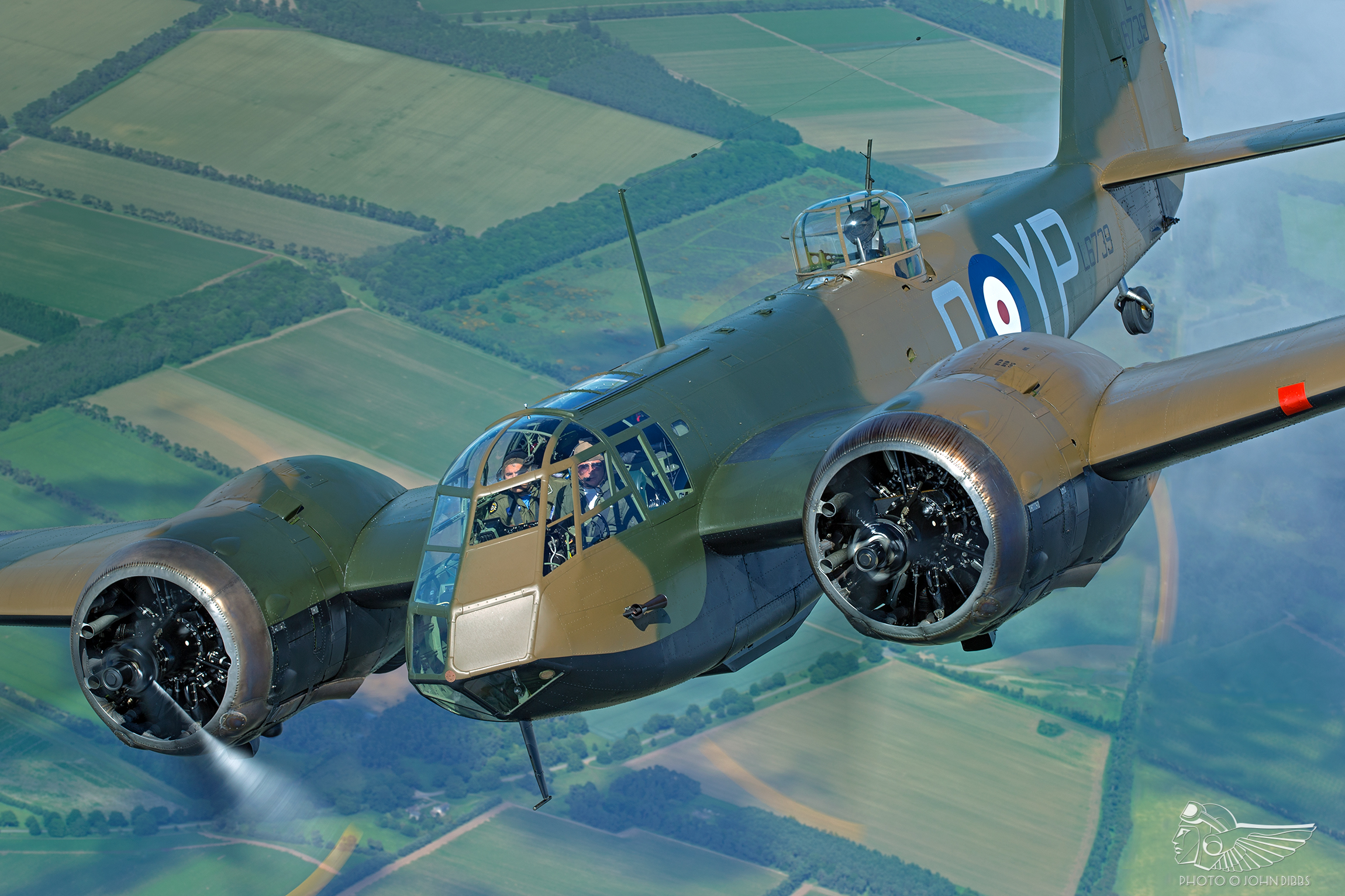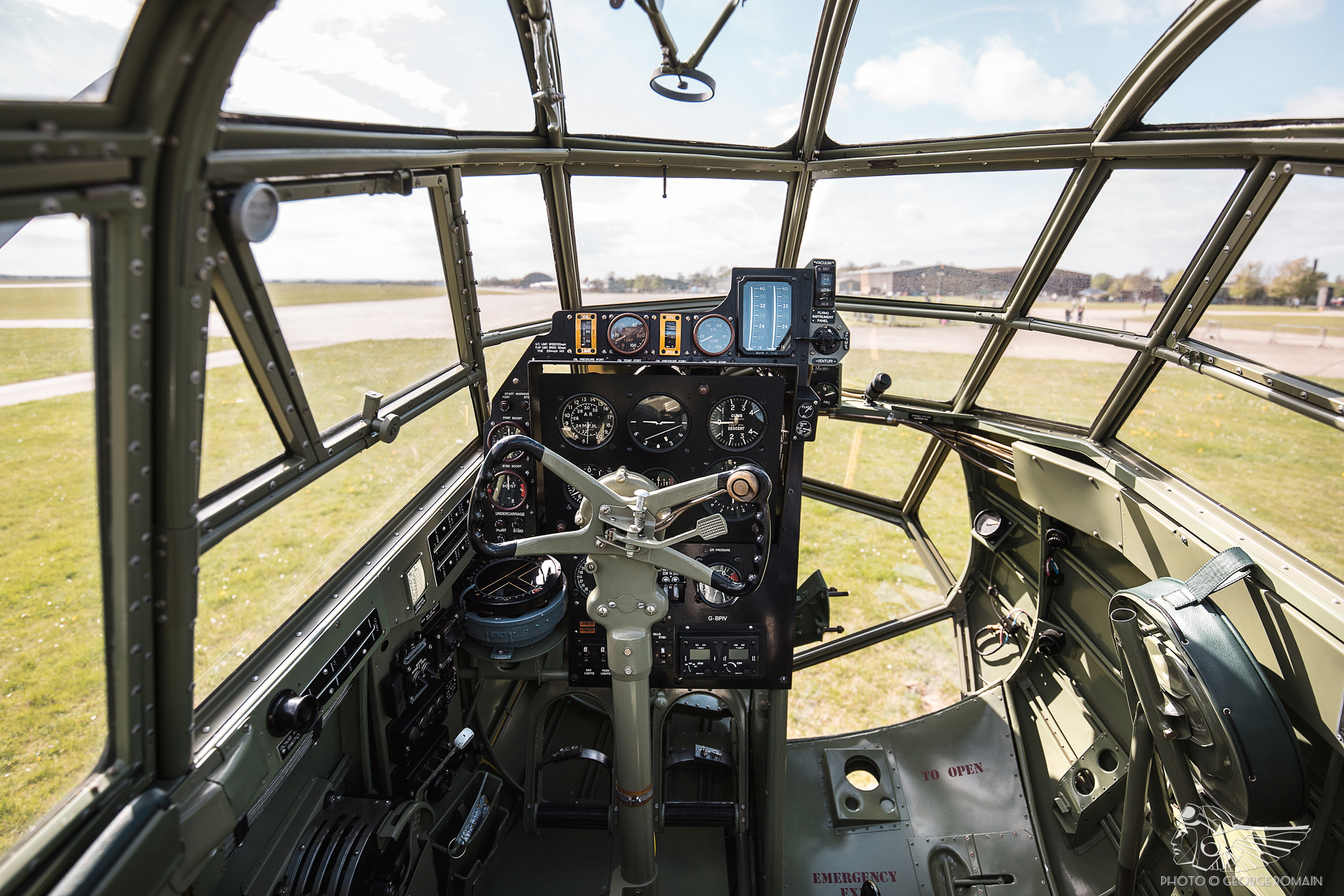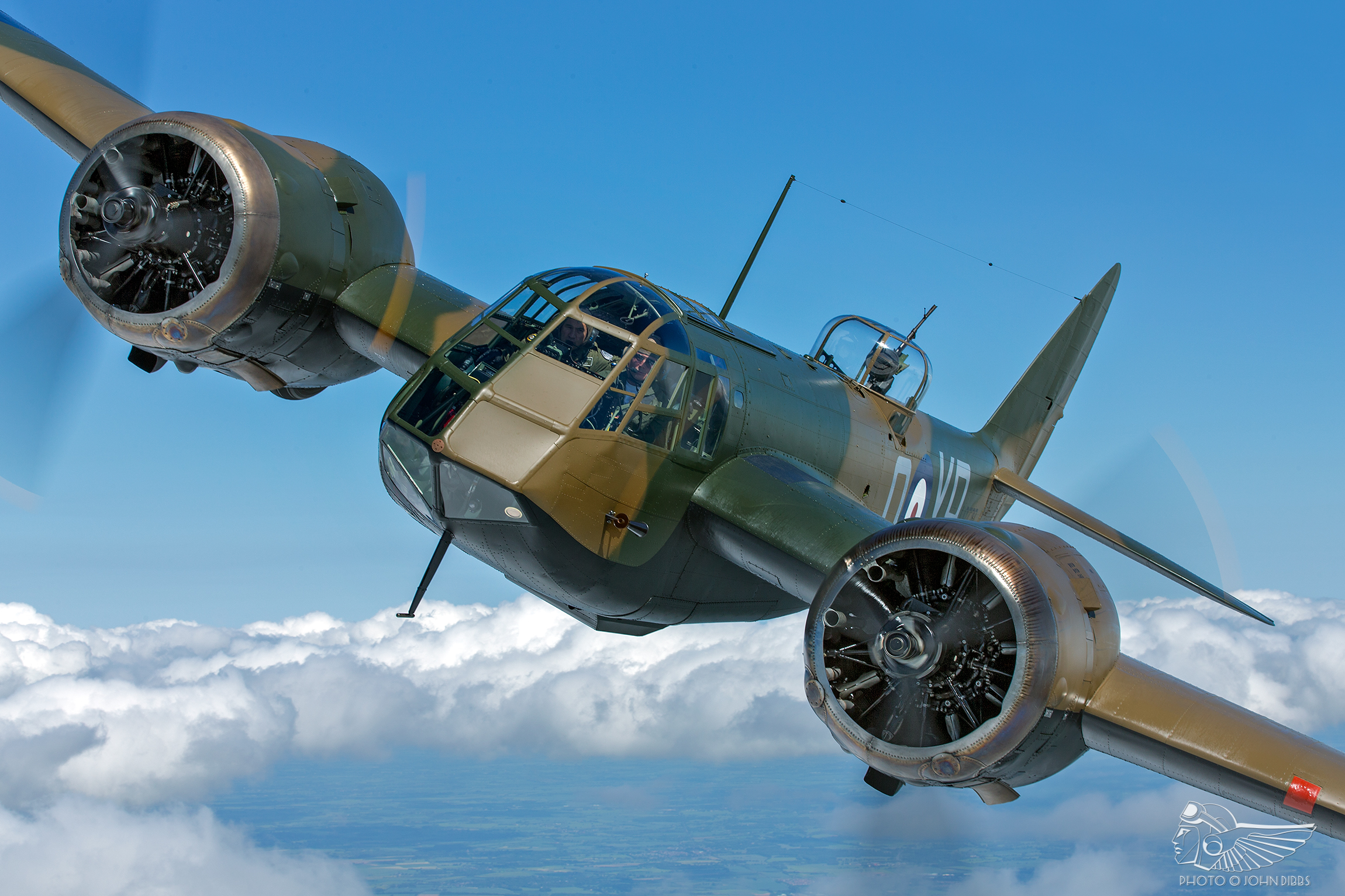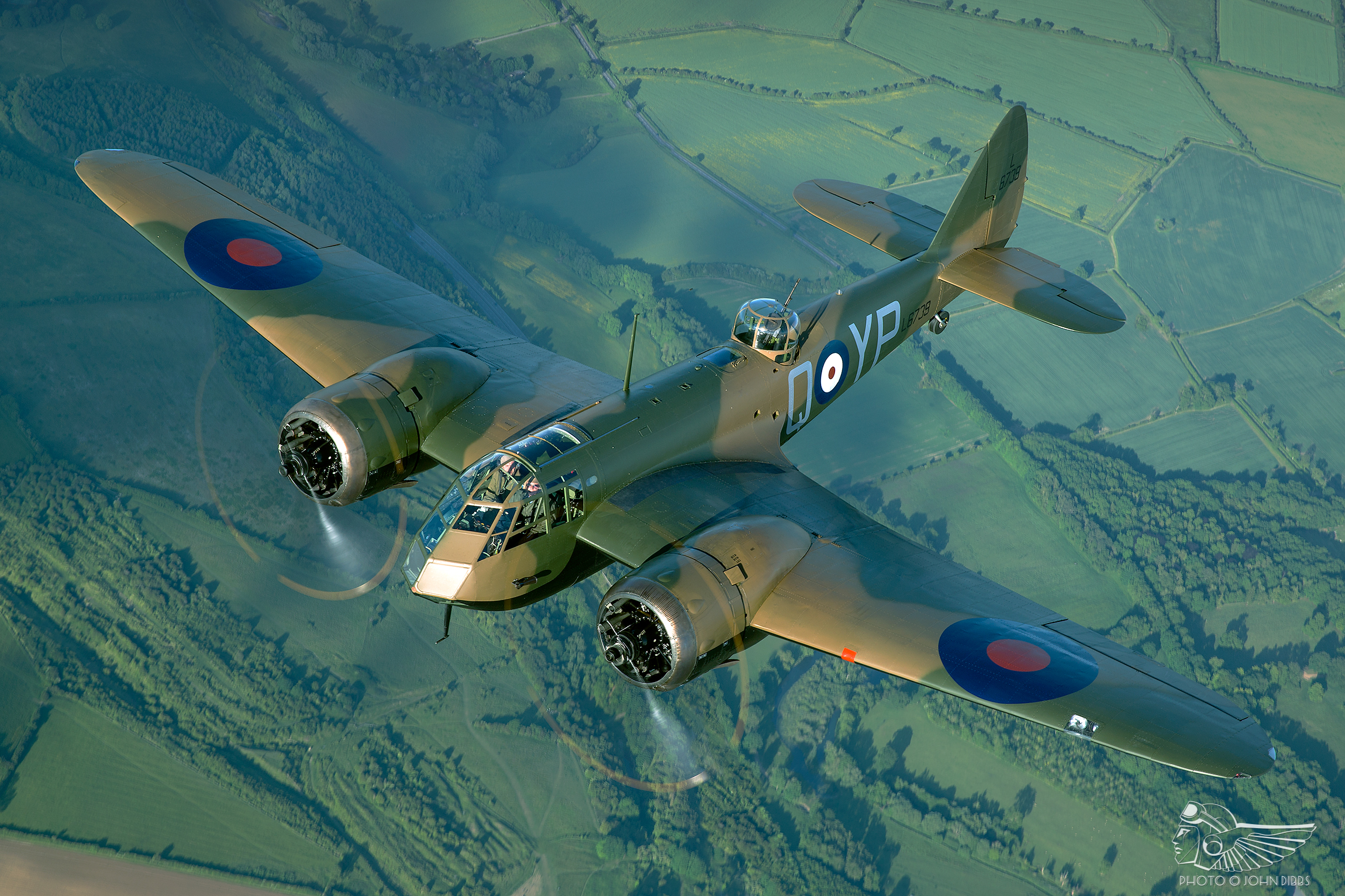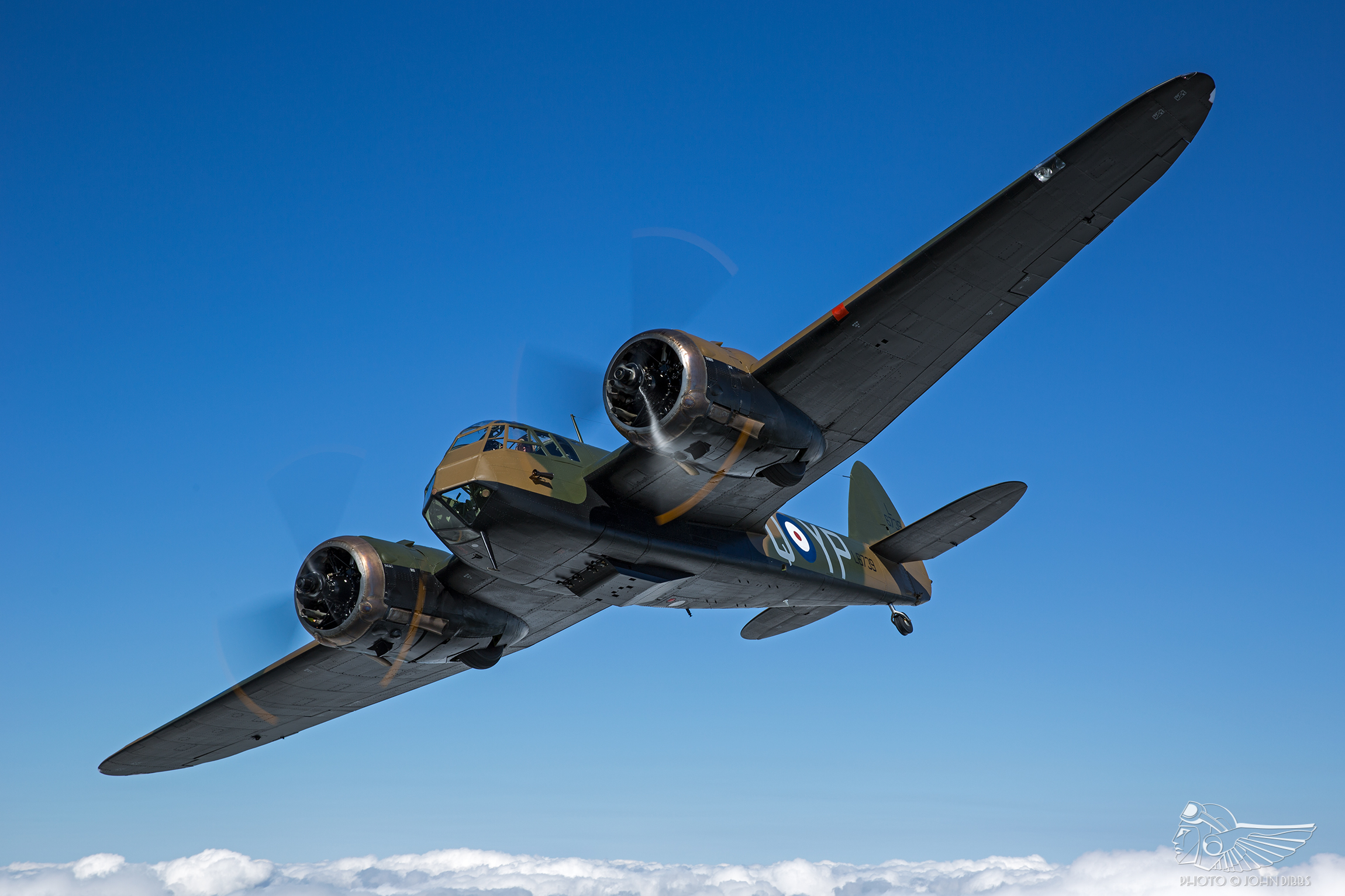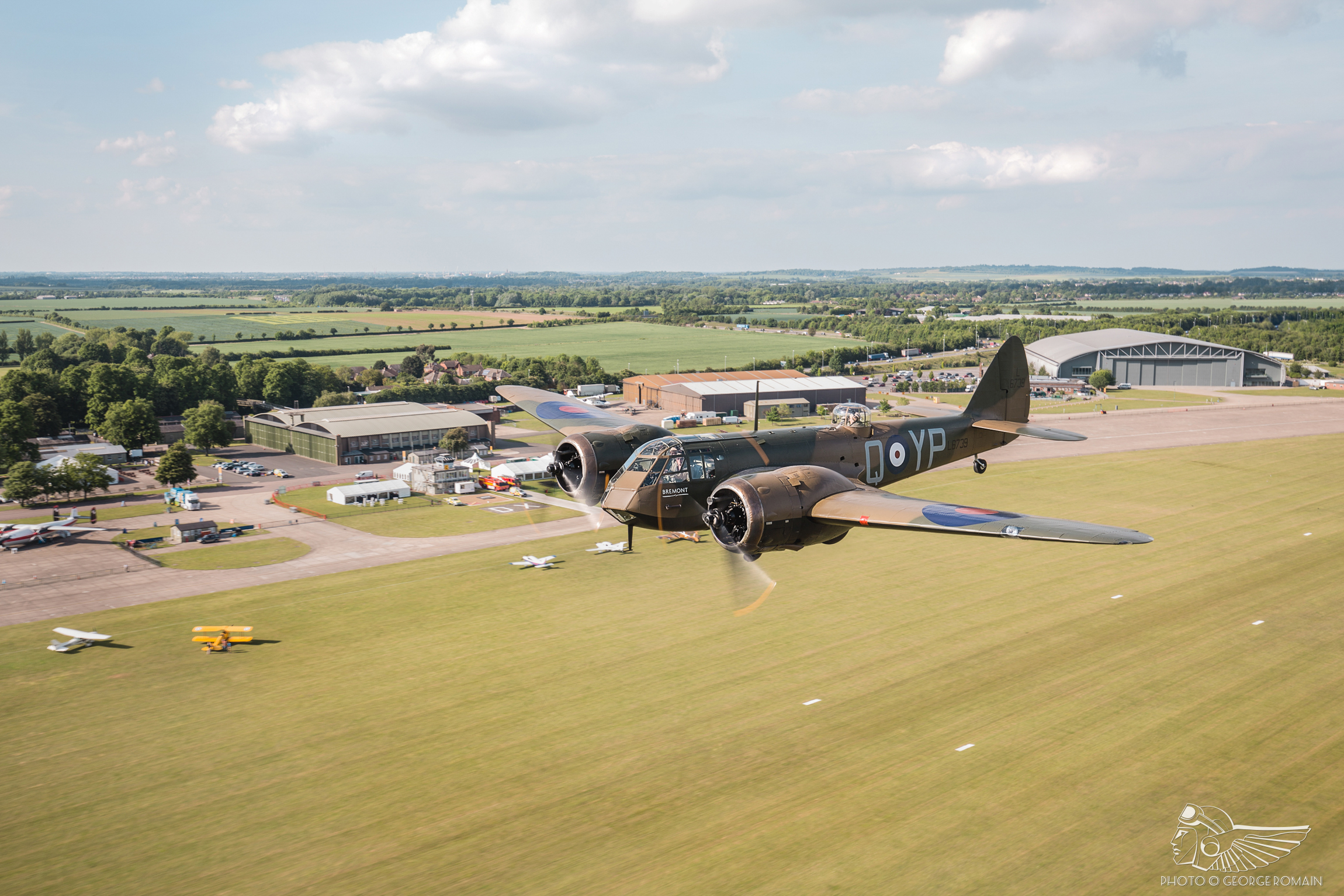John Romain has enjoyed a long and rewarding association with the Bristol Blenheim, the aircraft responsible in no small part for his path into the vintage aviation scene and the founding of the Aircraft Restoration Company (ARCo) at Duxford. Theirs is one of historic aviation’s most compelling stories, spanning more than 40 years and three restorations.
Designed as an airliner in the early-1930s by Frank Barnwell, Chief Designer of the Bristol Aircraft Company, the Blenheim was modified as a light bomber and pressed into service as the Royal Air Force’s (RAF) first stressed-skin monocoque aircraft with a hydraulically actuated undercarriage, flaps and dorsal turret. Its all-metal low-wing alclad-covered fuselage and two-spar stressed skin cantilever structure was ahead of its time, and on introduction in March 1937 it became the fastest aircraft in the RAF’s inventory, with a maximum airspeed in excess of the era’s biplane fighters. Of nearly 4500 Blenheims manufactured, just one remains airworthy – a Mk.I night fighter, the flagship of ARCo’s fleet.
John Romain’s association with the Blenheim traces its roots to 1972. Visiting Duxford as a 13-year old eager to see where the 1969 Battle of Britain film was shot, he found the airfield had fallen into disrepair during the intervening years and though the derelict hangars still wore their movie camouflage, vandalism was rife and most of the windows had been smashed. Visits became a regular occurrence as John integrated himself into the East Anglia Aviation Society to assist with the voluntary care and maintenance of the Imperial War Museum’s larger exhibits (which were in the process of being relocated to Duxford for storage), sweeping hangar floors at weekends as a means of getting up close to the preserved aircraft. An engineering apprenticeship with Hawker Siddeley Dynamics followed in 1976, work on complex missile systems at Hatfield exposing him to a range of machining, tooling and maintenance skills and forming the basis for expertise that would serve him throughout his career.
At this time, Royal Canadian Air Force (RCAF) pilot Ormond Haydon-Baillie began to relocate his fleet of historic aircraft to Duxford. Haydon-Baillie had acquired a number of airworthy aeroplanes and restoration projects during his time in Canada, amongst them a Hawker Sea Fury and a pair of Lockheed T-33s, as well as two Canadian-built Blenheim Mk.IVs, manufactured under licence as the Bolingbroke (hereafter referred to as Blenheims for simplicity), which arrived in 1974. It was Haydon-Baillie’s ambition to restore one Blenheim to flying condition, with the other to be completed for static display, and the team set about collating knowledge and equipment required to begin the project in the mid-70s. Volunteering to assist the fledgling operation, John and his colleagues established an on-site aircraft maintenance and restoration facility. “We looked around the site and found what is now known as Building 66, and that became our workshop”, he remembers. “We spent a number of months chiselling out panes of glass from surviving window frames to install in Building 66. With no electrics on-site at all, we had to set up an external generator – it was very primitive in those days.”
Haydon-Baillie’s loss in a P-51 Mustang in Germany on 3 July 1977 brought the venture to an abrupt end. In the wake of his death, John and the team assisted Wensley Haydon-Baillie, brother of Ormond, with the disposal of the many aircraft inherited by the estate, travelling across the globe to recover Spitfires from India, T-33s from Canada and Sabres from Germany, amongst others. Time was of the essence, with the IWM pressing for the removal of the Haydon-Baillie estate’s aeroplanes to make way for the opening of their new public museum. Coincidence would have it that at the very same time in July 1978, Graham Warner of the Chequered Flag Garage Group had been invited to visit Duxford by Robs Lamplough, whose aeroplanes were hangared there. Amongst Israeli Spitfire wrecks, numerous Mustangs, a rare Yak-11 and others, Warner spotted the main fuselage and nose of one of the Haydon-Baillie Blenheims in the corner of the hangar, its RAF roundels barely visible amongst its fading yellow paint. Stacked nearby were two centre-sections with rusted engine mounts and undercarriage frames. In Building 66 lay the second of the Blenheims, looking forlorn in a similar condition to its sister-ship. After consultation with Haydon-Baillie’s team, Warner acquired one of the aircraft, gifting the other to the IWM as part-payment for renewed use of Building 66 as a workshop, and assembled a team to begin the restoration. John ‘Smudge’ Smith, an ex-RAF trained metalworker, was instrumental to the build. Colin Swann joined to work on electrical and hydraulic systems, with Neville Gardner responsible for restoring the rare Bristol Mercury engines. John Romain concluded his apprenticeship at Hatfield and moved to Cambridgeshire to join the team full-time in 1981. The unprecedented restoration of Blenheim G-MKIV set an industry standard, tackling and overcoming innumerable technical challenges throughout every stage of the project – the overview presented here is a mere précis of the vast task undertaken by John Romain and his colleagues, the sum total of which amounted to 40,000 voluntary man-hours.
The Blenheim’s maiden flight came on 22 May 1987 with its Chief Pilot, the late John Larcombe at the controls. Painted in 105 Squadron colours as V6028, coded GB-D, the mount in which Wing Commander Hughie Idwal Edwards won the Victoria Cross on 4 July 1941, the world’s first civilian Blenheim made its much-anticipated début at the Biggin Hill International Air Fair, honouring several commitments before displaying at Denham aerodrome on 21 June. There the Blenheim appeared in the hands of reserve pilot Roy Pullan (with John Romain and ‘Smudge’ Smith on board), carrying out four fly-bys followed by a ‘dirty’ pass. An unauthorised, unrehearsed touch-and-go came next, during which the aircraft touched down deep into the short runway. Pullan quickly opened the throttles, the rapid application of power choking both engines. The Blenheim’s starboard engine regained power two to three seconds before the port engine, swinging it from the runway. With its airspeed very low and the aircraft approaching the airfield boundary, the pilot continued the manouevre and tipped into a stall at around 50ft. The Blenheim departed the runway, its port wing clipping a tree and cartwheeling it into Denham golf course. Mercifully, Pullan, Romain and ‘Smudge’ Smith (who had been sat in the rear turret) survived the crash with injuries – the Blenheim, however, was damaged beyond repair.
“That was absolutely devastating for the whole team and Graham personally”, John reflects. By that point, he had obtained his PPL and had started flying vintage aircraft under the tutelage of John Larcombe. “I decided to get a commercial pilot’s licence and get into airlines as I’d realised restorations were long, hard work and when they went wrong, it hurt!” That licence followed in 1989, but a dearth of positions in the airline industry left John with “no work and a big debt to pay off from the commercial licence”. Concurrently, Graham Warner had persevered to restore a second Blenheim. “I told Graham that if I was coming back to work on that project, I didn’t just want to do it as an engineer”, picks up John. “I suggested we form a company together and use external work to generate the funds for the next Blenheim.” From that proposition, ARCo was born and restoration and maintenance immediately began on a raft of third-party aeroplanes. The new airframe, a Bolingbroke Mk.IV T manufactured by Fairchild Aircraft Ltd in 1943, was transported from Strathallan to Duxford in February 1988 and work began in earnest. A five-year restoration followed, the culmination of which saw the Blenheim, now registered as G-BPIV, painted all black as a 68 Squadron night fighter coded WM-Z with serial number Z5722, taking to the skies at Duxford on 28 May 1993. ARCo endeavoured to repaint the aircraft every three years or so as a solution to the many requests from ex-Blenheim crews who wanted to see their units illustrated, and in succession the Blenheim wore markings representing Coastal Command and Bomber Command squadrons.
The Blenheim Mk.IV enjoyed a terrific ten-year run of airshow appearances until suffering an incident in August 2003. Returning to Duxford following an air display, the pilot had failed to notice that one engine had been burning fuel at a faster rate than anticipated and the aircraft essentially ran out of fuel on final, clipping the earth bank near the runway 24 threshold and ending up on its belly with severe damage. To lose the second Blenheim, again through no mechanical fault of the aircraft, was a critical blow, not least for Graham Warner, who entrusted the project to ARCo and relinquished his role in any future restorations. The decision to carry out a third rebuild was taken within months of the incident, the aircraft’s ownership transferring to Blenheim (Duxford) Ltd in December 2003 and a team comprising full-time engineers and volunteers beginning work in 2005. At that point, John continues, “There were no existing Mk.I Blenheims anywhere in the world, not even in museums. We knew restoring the aircraft to Mk.I configuration would increase the timeline quite dramatically, but we wanted to do something unique and challenge ourselves, which is very much the ARCo ethos.”
Extensive repairs to the aircraft’s damaged engines, wings, airframe and control surfaces and the fitment of a Mk.I nose section prolonged the restoration for almost a decade. The Mk.I cockpit section necessitated the rerouting of ancillary controls including throttles, pitch, carburettor and hydraulics as well as large amounts of electrical wiring. Bristol employee Ralph Nelson owned the cockpit post-war, mounting it to an Austin Seven chassis and driving the hybrid around Bristol until it was damaged by fire in 1957. The data plate in the nose identified it as the cockpit section from an Avro-built Blenheim Mk.I, issued to 23 Squadron on 2 September 1939. The aircraft operated as a night fighter during the Battle of Britain before suffering damage that rendered it inoperable in December 1940. The chosen colour scheme was that of this 23 Squadron night fighter, with the codes YP-Q and serial L6739 representing a Mk.I(F) fitted with an underbelly Browning .303 gun pack, 1939-40 era camouflage and matte black undersides. It flew again post-restoration on 20 November 2014 in the hands of John Romain, marking the completion of the third Blenheim restoration at Duxford.
ARCo’s Blenheim is one of the rarest historic aircraft flying in the world – the sole surviving airworthy example of an historically important aeroplane, and a unique Mk.I variant no less – and the level of care and maintenance afforded to the aircraft and its two rare Bristol Mercury XX engines is commensurate to its rarity. The Blenheim has been in great demand since it re-joined the airshow scene in 2015 and the years of expertise accumulated by ARCo and its engineers, through good times and bad, is brought to bear on the aircraft each time it flies. A scheduled commitment requires several hours’ engine maintenance before either of its two pilots – John Romain and Lee Proudfoot – step into the cockpit. The start-up procedure begins the day before a flight, the ritual taking a team of two engineers up to five hours to complete. If the Blenheim has sat stationary in the hangar, the oil in each Bristol Mercury will have dissipated through the engine, settling in the bottom cylinders. The consequences of a premature start-up in these conditions could be catastrophic and meticulous pre-flight maintenance mitigates against this.
“If we were to start those engines from cold without oil priming, it would take up to a minute for the oil to reach the main bearing and you’re running the risk of damaging it”, John continues. “You’re risking a hydraulic lock if you don’t turn the engine through before start-up, whereby the piston hits the oil settled in the bottom cylinder and its lack of compressibility could bend the connecting rod. The engine won’t fail for two or three hours, but it will fail.” Accordingly, engineers will attend to each engine in turn, with the cowlings removed, oil sump drained and ignition plugs removed from the bottom cylinders. The propeller is turned through several blades by hand to distribute the oil across the nine cylinders, after which the ignition plugs are put back into the respective cylinders and a special rig is plumbed into the aircraft through which hot oil is supplied under pressure through the main bearing and other parts of the engine. On the day of the flight the engineers will go through the air, fuel and oil systems as part of a standard pre-flight check. The Mercury has a total-loss grease and oil system on the cylinder heads, with no oil fed directly to the heads, and the valve gear (comprising four valves per cylinder) must be lubricated with grease and oil pads every ten hours. “The engines demand a lot of maintenance”, adds John. “You know where the boys have been working and your pre-flight walk-around gives an oversight to that, checking the sump plugs have gone back in, the cowlings are attached properly and so on. Otherwise, it’s a standard walk-around.”
Access to the aircraft is accomplished via a sliding Perspex hatch on top of the fuselage. With the exception of the cockpit seat frame carrying the elevator, rudder and aileron feed controls, the Mk.I cockpit is a total departure from the more traditional Mk.IV layout which saw instrumentation grouped in front of the pilot and the throttles sat in the middle of the cockpit, as is standard on most twins. Not so the Mk.I – the main panel immediately in front of the pilot comprises of a compact bank of blind flying and engine instruments, with the compass and electrical switches to the port. Throttles and mixtures sit in a quadrant to the pilot’s left, and a series of hydraulic levers and wheels to his right. Propeller pitch controls and carburettor cut-outs are behind and below the pilot, whilst vital engine instrumentation is mounted above and behind him. Electrical controls, including the batteries and master switch, are in the rear fuselage. The view forward is very good, though the Mercury engines restrict visibility to the sides. “The Mk.I has controls and instrumentation literally all over the place”, says John. “Some of it is nonsensical. For example, the cylinder head temperature gauges are over your right shoulder, which is an odd place to position such vital instruments. The cockpit is illogical and by its very nature, complex. There is no automatic scan process that can happen because you’ve got to look behind you, above you, in front of you and to the side to check instrumentation. In terms of the throttle, I still have the muscle memory from the Mk.IV and if we’re in the cruise, I find myself holding the control column with my left hand and reaching for the throttles with my right. That intuition is still there, even though I’ve spent hours and hours in the Mk.I cockpit!”
With the pilot and Flight Engineer crewed in, electrical generators, fuel flow and pneumatic power are turned on, control movement assessed for full and free movement and fuel tank gauges (mounted in a panel above the pilot’s head) checked. Start-up begins externally, with the engineers manually fuel priming the engines. The Blenheim is designed to keep fuel out of the cockpit as a means of preventing in-cockpit fires, with even the fuel pressure gauges running on capillary lines with a neutral fluid, and the engines are primed via pumps in the undercarriage bays built into the engine nacelles. A cold engine requires three initial ‘hard’ primer shots to inject fuel into the cylinders and the propeller is pulled through by hand for four blades to distribute fuel through the respective cylinders. A further two hard shots and the engineers will screw the primer back into closed position – firmly locking the primer is essential to avoid the cylinders sucking fuel through the primer lines on the engine’s start-up induction cycle and running too rich.
The pilot initiates the start-up sequence for the left engine first by turning both of the respective magnetos on and cracking the throttle to ¼ of an inch before hitting the starter switch. The propeller will usually turn through two blades before the engine fires effortlessly. “We let the engine settle at an idle speed of around 700rpm while the engineers go to the right engine to start that”, John continues. “We have no way of knowing, other than through experience and visual checks, that the propellers are turning at around 700rpm because the tachometer readings start at 1500rpm.” A gradual warm-up sees oil pressure reducing from around 130psi to the optimum 90psi, by which time each engine will be showing 30-40° oil temperatures and cylinder head temperatures in the region of 110°. Propellers are adjusted from coarse to fine pitch ahead of the taxi to the hold.
At the pilot’s command, the engineers remove the chocks and the aircraft rolls forward, a quick tap of the brakes checking the pneumatic system. “Taxying is very easy,” says John, “as the large rudder gives good authority and you can use a combination of brakes and throttle to turn on the ground. A differential unit controls the brakes, with the appropriate rudder input and a tap on the brake push lever on the control column putting air through to the respective wheel brake bags. When the pendulum-type rudder pedals are neutral, applying brakes will put even pressure to both.” At the runway holding point, hydraulics are checked by lowering and retracting the flaps, engine temperatures and pressures are reviewed and emergency procedures briefed with the Flight Engineer ahead of the final power checks.
“We want to do the power run just before we get airborne”, says John. “If we power check and sit there with the engines at idle, the plugs will start to foul up and you’ll feel a mag drop building. This can lead to an engine failure during the take-off run.” Advancing the throttle to -4 lb./sq.in. boost, the propellers are cycled twice from fine to coarse pitch. The Blenheim’s engines power two rare de Havilland Type 4/3 three-bladed variable-pitch airscrews, which operate in two stages – fine and coarse – depending on flight conditions. The plunger-type controls sit on the port side of the cockpit, aft of the pilot’s seat, requiring dexterity to reach behind and feel for the respective levers. In one of the Blenheim’s many “ergonomic nightmares”, the carburettor cut-out levers are mounted in the rear control bank above the propeller pitch levers; though shielded by a spring-loaded cover to prevent their inadvertent use, John explains that a pilot reaching to adjust pitch could easily flip the cover, pull the carb cut-out lever and accidentally cut-off the fuel supply to one or both engines. “The levers have the exact same shape and feel and you can’t see them unless you physically put your head down,” John says, “meaning it’s so easy to knock the protective flap – the reduction in rpm in both circumstances means you could momentarily confuse engine cut-out with propeller pitch change”.
The throttle is advanced steadily to 0 lb./sq.in boost and all four magnetos are checked in sequence, the pilot watching for no more than a 100rpm drop on each tachometer. The gills on the trailing edge of the cowling, which govern the flow of cooling air for the engines, are closed immediately before take-off (and remain closed when airborne as the cylinders will receive adequate in-flight air-cooling) using an electric switch (a remnant of the Mk.IV cockpit, replacing the cranking wheel in the original Mk.I for practicality). “If you leave the cowling gills open in full position, the aircraft simply will not get airborne”, explains John. “It will lose so much elevator authority that it will go off the end of the runway.” Taxying onto the runway for take-off, the pilot ensures propellers are in fine pitch (the Blenheim cannot achieve flight in coarse) and slowly advances the throttles to -2 lb./sq.in. boost for the initial take-off roll, nudging forward to 0 lb./sq.in. boost. With a steady application of power and careful rudder input, gyroscopic precession is minimal.
A series of possible rejected take-off and engine failure on take-off scenarios are briefed with the Flight Engineer. “If we have any engine issues before rotation, we are closing the throttles, braking and staying on the ground”, John affirms. “If we’re airborne but below 130mph, we’re closing the throttles and landing. If we’re airborne at or above 130mph with a positive rate of climb, we’d go to maximum power at +4 ½ lb./sq.in. boost on the remaining engine and continue the climb. If we lost the left engine through a massive seizure and it stopped spinning, we would lose all hydraulics because that’s where the hydraulic pump is. The Flight Engineer would then need to start pumping the gear retraction hand pump immediately to reduce the huge amount of drag created by the gear doors.”
Undercarriage is retracted before 130mph using a spade-grip push-pull handle. The gear position lamps on the instrument panel initially illuminate green lights when the undercarriage is down, changing to red during travel before the lamps go out with the locking of the gear in the engine nacelles. A 0 lb./sq.in. boost climb is maintained and as the airspeed advances through 150mph at between 350 and 500ft, both propellers are brought into coarse pitch and thereafter changes in boost or airspeed will govern the rpm. “That’s like changing gear in your car,” says John, “and you’ll see and feel the difference as the aircraft settles to around 1800rpm”. The Blenheim picks up speed easily in level flight and the throttle is closed to -2 lb./sq.in. boost in the cruise, achieving an airspeed in the region of 180mph at which an oil temperature of around 60° and oil pressure of 90psi can be maintained. Longitudinal stability is good, though the short nose and big fin and rudder give the Blenheim Mk.I lateral instability and a tendency to “wander”, particularly in more turbulent air. A complete hand and foot release from the controls will identify any need for trimming, which typically is required to correct nose-down pitch following boost and propeller adjustment, undercarriage cycling and flap deployment, and to address the change in centre of gravity resulting from fuel burn.
Automatic mixture is brought from ‘Normal’ (rich) to ‘Weak’ (lean) via mixture control levers on the throttle quadrant to the port side of the cockpit, dramatically reducing fuel consumption to around half a gallon a minute whilst being more sympathetic to the Mercury engines (which tend to oil up if mixture is left in ‘Normal’), with no discernible performance difference. On clear, cool days, carburettor icing is a concern and a close eye is kept on the air temperature gauge to the top right of the instrument panel. Blenheims were renowned for icing up, with the formation of ice in the carburettor restricting airflow to the engine. “The Blenheim Mk.IV had temperature probes in the air intakes, which provided an accurate reading,” says John, “but the Mk.I relies on the outside air temperature gauge and the pilot’s intuition alone. If the temperature is low enough, you select the carb air to ‘Warm’. You won’t see any rpm drop but the carb is now being fed warm air from around the cylinders, which prevents the air from icing up as it passes through the carburettor. The one area that you can run into trouble with is where you are descending from high altitude. You would close the throttles to avoid over-speeding on the descent, which will reduce the cylinder head temperature and, in turn, cool air is being fed to the carb. You can super-cool the engine at that point, and though it won’t normally affect us in the day-to-day operation of the Blenheim, it’s something to keep at the back of your mind”.
In-flight management of the nine-cylinder air-cooled Bristol Mercury XX radial engines is at the forefront of the pilot’s mind during any flight. ARCo has been restoring, maintaining and operating Bristol Mercuries in multiple types for 30 years, making them one of the leading authorities in its operation. John emphasises that, “Fundamentally, the Mercury is a simple engine, but there are ground rules and best practices to looking after them. The old engines, especially the radials, have a particular need for careful, smooth operation and we identified that pretty early on. We lost the first Blenheim because of a complete misunderstanding of what those engines are capable of.” This translates to conservative engine management, and the strict avoidance of opening and closing the throttles too quickly – throwing the throttles open may mean that an engine running at a slower speed cannot absorb the fuel-air charge produced by the jump in boost, increasing pressures in the cylinder heads and risking detonation. The Blenheim’s Mercuries are limited to +4 ½ lb./sq.in. boost (modified from +9 lb./sq.in. by the Canadians for training purposes) and only half of this available power is used at any point in-flight outside of annual flight testing, with boost greatly reduced in the cruise to maintain lower rpm. “Keeping the throttle input, power settings and rpm sympathetic to the engines is the key. Before increasing boost, you will increase rpm first to enable the engine to spool up a lot quicker against the propeller. With a fixed-pitch propeller, if you slam that throttle the engine is trying to make the propeller spin but the airflow over the blades causes drag, and is slowing the process down to the extent that you end up in an over-boost situation where you’re putting a lot of fuel mixture into the cylinders that can’t handle it.
“You can do so much damage to an engine through throttle mismanagement”, he stresses. “If you take pilots who have a tendency to slam throttles, they will destroy an engine very quickly. It won’t necessarily fail immediately, and it could happen five or so hours down the road, potentially with another pilot flying it. It will either damage a valve, crack a cylinder head or blow a cylinder head instantly – I’ve seen a B-25 where the head had departed and taken the side cowling with it. Bad handling will wreck an engine and not understanding what is going on underneath those cowlings could be disastrous.” As an engineer himself, John has vast first-hand experience of restoring and overhauling Blenheim engines and has a keen appreciation of their intricacies. “When you’ve stripped and rebuilt an engine, you understand it. That knowledge means that if you have a partial or main failure, you can identify what’s going on, what you can still retain from that engine and what you’re going to lose. That will dictate the final outcome of whether that aeroplane ends up on the ground on its wheels, in a field on its belly or worse. In some ways, it’s a negative to the enjoyment factor as you are constantly aware of how the aircraft is behaving, and that focus can detract from the unique experience of flying it.”
The Blenheim’s sweeping fast passes, arcing wingovers and the guttural purr of its Mercuries make it a graceful and popular airshow act. Air displays begin with a shallow dive in to the venue from 1000-1500ft with throttle set at 0 lb./sq.in. boost, carb heat set to ‘Cold’ and mixture returned to ‘Normal’, the inertia giving the aircraft a speed of 220mph for the first pass and requiring a touch of nose-down trim which will be wound off as energy is lost. “The whole display is about converting height into energy and energy into height”, John says. “What you don’t want is to end up low-level with no energy, which you will do if you fly straight or top-side passes and low turns. I’ll always break off the A-axis display line at 30-45°, climbing into a big wingover which gives me height ready for the next pass. Being high away from the crowd, visually you can always see crowd centre. I fly and teach ARCo pilots to use that banking to see the whole site, to visualise where the next manouevre will be and adapt that turn accordingly. If you turned low away from the airfield, you would lose sight of the dynamics of the display site.”
Energy management is key to the climbing and descending series of figure-eight turns, with the airspeed reducing to no lower than 110mph during a wingover. Aileron authority remains good as airspeed changes between climb and descent and though the large wing area offers excellent lift, elevators and rudder become heavier during steeper wingovers and pulls and the controls are not particularly well harmonised. “If you’re too slow on a wingover and you allow some negative-G to come in, you will lose one or both engines momentarily”, John warns. “If you’re slow at that point and lose one engine, the other engine will corkscrew the aeroplane. You have to be aware that if you lose an engine, you need to push the nose down and fly away from the manouevre – if you try and pull back, it will tumble in.” Slow-speed handling is pleasant, and considerable elevator buffet precedes a benign stall with no major stick deflection or out-of-trim force. “With the propellers in fine pitch, power back and the aircraft held in a high angle of attack, it’ll nibble at about 70mph but won’t stall until 65mph, with a pronounced nose drop. With gear and full flap adding drag, there’s a lot of buffet and it will sit at 60mph until the right wing departs. The rudder is very effective and you can pick the wing up with rudder and an increase of power to fly away from the stall.
“For its day, the development of the Blenheim’s flying controls was quite advanced”, John reflects. “In most piston aeroplanes, turning in aileron will give you adverse drag on the ailerons which creates adverse yaw, and you lead slightly with some rudder to keep the turn in balance. The Blenheim’s ailerons operate in such a way that part of the control surface moves into the underwing airflow to counteract adverse yaw in a turn. That makes it a lovely aircraft to manouevre, particularly in the air display environment, as you’ll predominantly be turning using the elevator and ailerons with little rudder input required.” Though conservative power settings are used to preserve engine and airframe life, John enthuses that a display sequence flown at full-power would facilitate “an amazing high-energy routine”. ARCo’s Blenheim flies at a gross weight in the region of 8200 lbs, almost half of the in-service weight. Even with armour plating, ammunition, bombs and a full aircrew, early Blenheims were cleared for aerobatics and John asserts that “you could easily loop and roll it – to barrel roll it would be delightful with its power, energy and ailerons”.
Though early Blenheims outperformed many of their contemporaries, day-fighter Mk.Is had only a single forward-firing Browning .303 machine gun in the leading edge of the wing and turret-mounted .303s as defence and unescorted Blenheims were woefully outmatched by the Luftwaffe Messerschmitt Bf 109Es and Bf 110s that engaged them low-level during the early days of the conflict. Daytime operations suffered severe casualties, and there are sobering accounts of Blenheims flying in low-level echelon formations as Luftwaffe fighters stacked up behind them, methodically and almost cruelly picking off the aircraft one-by-one. In a combat situation, “The best thing for the Blenheim pilots would have been to turn into the attack”, muses John. Having flown both Blenheim and Bf 109E, he has a unique perspective of the engagement. “The 109Es would have had a field day – fast, fantastic ailerons and excellent manoeuvrability, they were great fighters for their time. You could, however, use the 109E’s speed as a disadvantage to that pilot to give him as little time as possible to get a shot at you. Turn into the attack and you’d have a closing speed of something like 600mph, which would only give the 109E pilot a second or two to shoot and he would probably peel off, go high and come back round for another go. 109Es were shot down by Blenheims… It’s interesting to consider that with the benefit of hindsight.”
Post-display, power is returned to -2 lb./sq.in. boost to help cool the cylinders. Pulling into the circuit with a standard break will wash off the remaining energy, putting the Blenheim downwind at the desired airspeed of 140mph at 1000ft. “From that point, we know that if we had an engine failure, we’d have enough height and airspeed to glide back to the airfield”, John says. “We’ve carried out power-off tests with the Blenheim at altitude during testing, and it has excellent gliding characteristics.” A hydraulic selector handle beside the pilot controls a valve which directs fluid for the aircraft’s systems, operating in three stages – turret (up), neutral (middle) and undercarriage and flaps (down). This is lowered to the down position in the downwind leg to ensure hydraulic authority over the undercarriage and flap units.
The undercarriage is selected ‘down’ below the gear limiting speed of 130mph as the aircraft descends through 900ft in the downwind leg. “It’s always a relief to me when I put the gear down and it locks”, remarks John. “If we lost a hydraulic line, for example, even the hand pump won’t work. We have two blow-down bottles but if we lost one of the lines feeding that to the gear bays, even that won’t work – the thought of landing wheels-up and damaging those very rare engines and propellers is awful.” Propellers are moved into fine pitch to assist the hydraulic pump in lowering the gear faster, and flaps are lowered to 10° using a push lever. This pitches the aircraft’s nose down, requiring counteracting trim.
Around 500ft and with airspeed bleeding below 90mph, the second stage of flap is introduced and the aircraft is descending rapidly now. With excellent aileron and rudder authority, a three-point landing attitude can be easily achieved even in a 15 knot crosswind and if airspeed is kept below 75mph, the aircraft can be stopped within 350 yards. On the landing roll the cowling gills are opened to direct cool airflow to the engine, and a close eye is kept on the cylinder and oil temperatures. Once parked, engines are left to idle at 700rpm for around two minutes to allow the scavenger pumps to direct engine oil back to the tanks, and are stopped by pulling the idle cut-outs, with the magnetos, fuel and electrics then switched off in turn.
Since its return to the airshow circuit, the Blenheim has been involved in a number of major events, including commemorative Battle of Britain 75th anniversary flying displays and fly-pasts at Fairford, Goodwood and Duxford in 2015. In September 2017 the Blenheim participated in perhaps the most impressive spectacle it has been a part of to date when it led a formation of three Spitfire Mk.Is, five Hawker Hurricanes and a Gloster Gladiator in the climactic sequence of Duxford’s Battle of Britain Air Show. Never before have we enjoyed such numerous and diverse representation of early-war RAF aviation and the Blenheim is very much at the head of that movement, illustrating the richness of the British historic scene.
John Romain has been inexorably linked to the Blenheim since the formative years of his involvement in the preservation scene he has actively helped to enrich for decades. As Managing Director and Chief Pilot of ARCo, he remains at the forefront of historic aircraft restoration and conservation. All of that history, he says, “Does mean that there’s a form of nervousness to it as you take it all airborne with you. You are constantly conscious of what is going on with the aircraft when you’re flying it. Very rarely do you sit sweet, quiet and happy in the cockpit – you’re enjoying the experience, yes, but you are very conscious of what you are in because any moment now, things could change and you could be dealing with an emergency. That’s the nature of the beast with vintage aeroplanes.
“Once you’ve landed and you’re sitting shut-down on the ramp, there’s a massive amount of satisfaction. You can then relax and enjoy the experience of having flown this beautiful, unique historic aeroplane. There’s been a huge amount of emotion and effort put into reproducing that machine. It carries with it the stories of all those aircrews from nearly 80 years ago. It’s our duty to ensure the survival of those stories well into the future, so that other generations might learn from them.”
With thanks to John Romain and the Aircraft Restoration Company.
![]()


